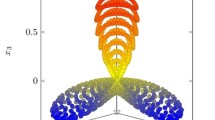Abstract
A simplified model for calculating the dipole and dipole–quadrupole polarizabilities Ai,jk is suggested. The model is based on the mean energy method and on the topological approximation to the bond order matrix. Pseudoinvariants of the Ai,jk tensor are calculated to evaluate the degree of molecular dissymmetry, which is responsible for the discriminating intermolecular forces. The method is illustrated by calculations for a number of chiral molecules and comparison of the calculated indices with the experimentally evaluated twisting ability of molecules during the nematic–cholesteric phase transition.
Similar content being viewed by others
References
V. A. Kizel, Physical Reasons for Dissymmetry of Living Systems [in Russian], Nauka, Moscow (1985).
Yu. S. Barash, Van der Waals Forces [in Russian], Nauka, Moscow (1988).
P. Hobza and R. Zahradnik, Intermolecular Complexes, Academia, Prague (1988).
G. S. Chilaya and L. N. Lisetskii, Usp. Fiz. Nauk, 134, No. 2, 279-304 (1981).
A. S. Sonin, Introduction to Liquid Crystal Physics [in Russian], Nauka, Moscow (1983).
W. J. Goossens, Mol. Cryst. Liq. Cryst., 12, No. 3, 237-244 (1971).
E. Buckingham, in: Intermolecular Interactions, from Diatomics to Biopolymers, B. Pullman (ed.), Wiley, New York (1977).
B. E. Pobedrya, Lectures in Tensor Analysis [in Russian], Moscow State University, Moscow (1986).
A. V. Luzanov and E. N. Babich, J. Mol. Struct. (Theochem), 333, 279-290 (1995).
G. Starkschall and R. G. Gordon, J. Chem. Phys., 56, No. 6, 2801-2806 (1972).
V. A. Gubanov, V. P. Zhukov, and A. O. Litinskii, Semiempirical Molecular Orbital Methods in Quantum Chemistry [in Russian], Nauka, Moscow (1986).
S. G. Wulfson, Molecular Magnetic Chemistry [in Russian], Nauka, Moscow (1991).
M. F. Vuks, Electrical and Optical Properties of Molecules and Condensed Media [in Russian], Leningrad University, Leningrad (1984).
H. Weiss, R. Ahlrichs, and M. Haser, J. Chem. Phys., 99, No. 2, 1262-1270 (1993).
G. Gottarelli and G. P. Spada, Mol. Cryst. Liq. Cryst., 123, No. 3, 377-388 (1985).
E. M. Aver'yanov, V. A. Zhuikov, and P. V. Adomenas, Zh. Teor. Éksp. Fiz., 81, No. 1, 210-216 (1981).
A. N. Shramkov and P. P. Shtifanyuk, Teor. Mat. Fiz., 90, No. 2, 246-258 (1990).
A. V. Luzanov, V. V. Ivanov, and R. M. Minyaev, Zh. Strukt. Khim., 39, No. 2, 319-327 (1998).
G. S. Chilaia and L. N. Lisetski, Mol. Cryst. Liq. Cryst., 140, Nos. 2-4, 243-286 (1986).
L. A. Batrachenko and L. N. Lisetskii, Zh. Strukt. Khim., 32, No. 5, 146-147 (1991).
L. A. Kutulya, V. E. Kuzmin, I. V. Stelmakh, et al., J. Phys. Org. Chem., 5, 308-316 (1992).
A. Ferrarini, G. J. Moro, and P. L. Nordio, Liq. Cryst., 19, No. 3, 397-399 (1995).
P. P. Shtifanyuk, Vestn. Khark. Un-ta, No. 454, 4(27), 182-185 (1999).
Author information
Authors and Affiliations
Rights and permissions
About this article
Cite this article
Luzanov, A.V., Lisetskii, L.N. Topological Model for Dipole–Quadrupole Polarizability and Its Application to Analysis of Discriminating Intermolecular Interactions. Journal of Structural Chemistry 42, 544–549 (2001). https://doi.org/10.1023/A:1013125405958
Issue Date:
DOI: https://doi.org/10.1023/A:1013125405958




